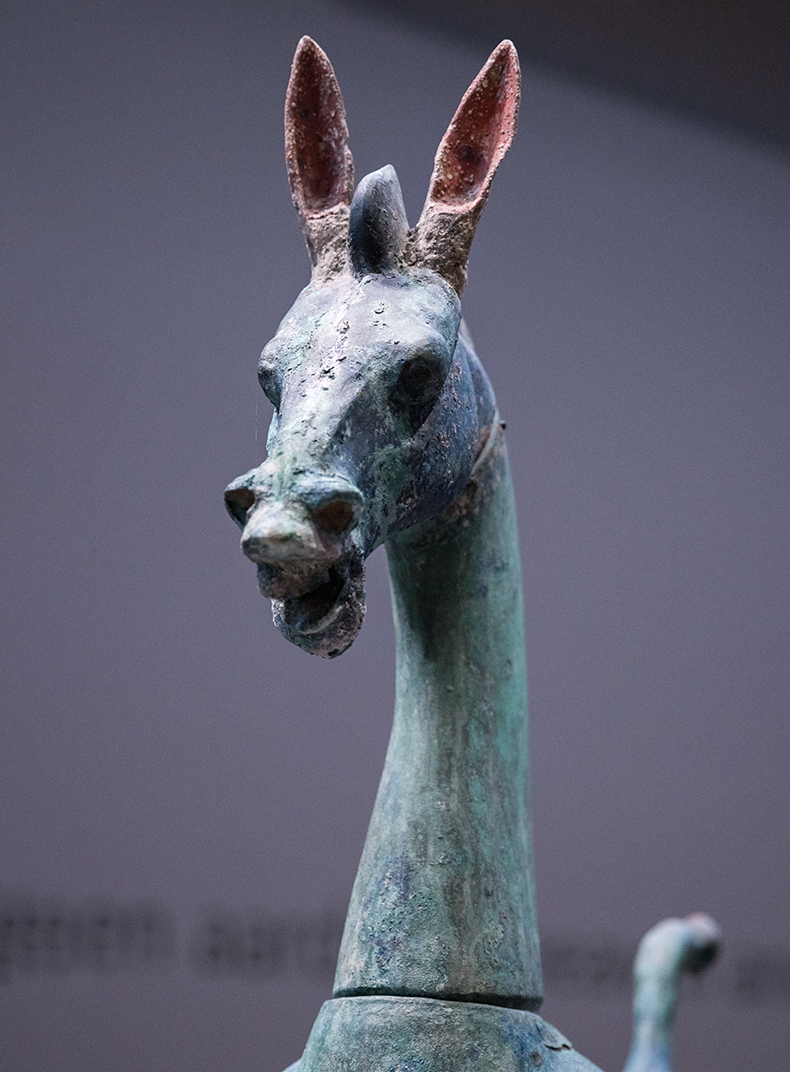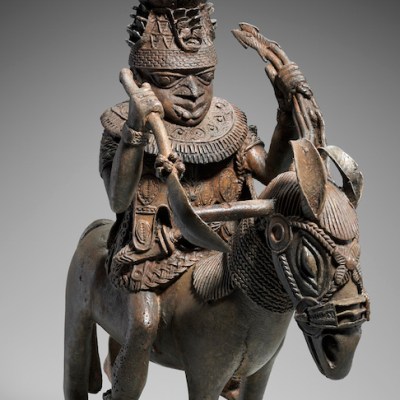From the November 2024 issue of Apollo. Preview and subscribe here.
This object, depicting a horse and groom, was made in the Eastern Han dynasty in China, between 25 and 220 AD, and is cast in bronze and decorated with pigment. It was purchased in the 20th century, and though we don’t know its original context, we know it has come from a grave or tomb, functioning as a burial object. The work is probably not complete; in the original setting, the horse would likely also have pulled a wagon, which is now missing. From this, we can presume that the owner must have been a high-ranking official, or even nobility; when he was alive, he would have used a horse wagon as transportation. In the period of the Han dynasty, people believed or hoped that after they had passed away, their soul would transcend to paradise; these objects are the equipment for them to be able to enjoy such status and luxury in the afterlife.
Having this kind of object in burial was common practice for nobility in the Han dynasty. In the exhibition ‘Asian Bronze’ at the Rijksmuseum, we have several other examples, including one from the grave of the First Emperor of the Qin dynasty (221–207 BC). At this time, bronze was regarded as an elite material, a precious metal, so a certain social status was needed to be able to afford such an object, even for household objects like a bronze mirror. In burial, one could also use a terracotta horse or terracotta groom, but instead they chose bronze, which says something about the financial situation of the owner of this tomb, who was much richer and could therefore afford to use bronze for a burial object.
Horse and Groom (c. 2nd–3rd century AD), China. Museum für Ostasiatische Kunst, Cologne. Courtesy Rijksmuseum, Amsterdam

When we date these objects, we still rely on style a great deal. This pairing of groom and horse is very close to other examples unearthed from graves or tombs from the Eastern Han dynasty, and therefore we date it to this period. Scientific tests are also sometimes used; they give a vague period and help us confirm the dating. This object was probably buried for a long time in the ground, coming into contact with humidity and water, resulting in its corrosion and overall green colouring. When bronze objects are first cast, they develop a dull, discoloured casting skin, which is removed by polishing to give them their shiny, golden colour. Over time, they oxidise: the surface colour gradually becomes dark brown, or sometimes even black. In general, we can tell if an object has been buried or not by noticing these characteristics; if it has a green patina, that usually suggests that the object has been buried for some time. Through scientific analysis we can determine the date more accurately – looking at how deeply the green patina has penetrated the metal; testing for a layer of cuprite under the surface, which can be an indicator of age; and seeing what other compounds are present, such as phosphates or oxalate, which might give an idea of burial conditions.
The horse was cast hollow, in separate sections – head, neck, four legs, tail and body were all cast individually then pieced together, which speaks to the efficiency of Chinese bronze workshops. Remnants of pigment, which would have been used to decorate the bronze, are still present on the horse, on its tail and ears. How much pigment would have been present originally is difficult to say, because most of the examples we see have only partial decoration remaining.
At this time, there were two major ways of casting in China. One, which was almost universal, was lost wax casting. In this process, first you made a model with wax, which was then surrounded with clay. When you poured the smelted metal into the mould, the heat of the metal would melt the wax and fill the space that wax created. But during the Shang (c. 1600–1046 BC) and Zhou dynasties (c. 1046–256 BC), artists and artisans practised another mode of casting, in which they used clay moulds in pieces. With this method, they could carve decoration directly into the clay mould to conduct the casting. The advantage of casting in separate sections is that it reduces the failure rate that comes with casting an object of this size in one go. This piece-mould casting method existed only in China.
Horse and Groom (c. 2nd–3rd century AD; detail), China. Museum für Ostasiatische Kunst, Cologne. Courtesy Rijksmuseum, Amsterdam

We don’t know much about the bronze manufactory workshops in the Han dynasty, nor the ancient artists or artisans who would have made this bronze; they didn’t leave their names on the object. From archaeological findings at a site near Anyang, in Henan province in South Central China, where bronze manufactory workshops have been unearthed, we know that during the Shang dynasty there were already very advanced bronze-casting workshops which functioned almost like a modern factory. They had flow lines, a smelting section and a casting section; the casting moulds themselves would also have been made in these workshops. In the larger historical context, the cultural centre of China, and the heart of the country, is the Central Region, with the capitals of the Shang, Zhou and even Han dynasties nearby; but, interestingly, most of China’s copper mines are outside the Central Region. That means that the ruling class of the country would have used their resources to generate copper sources from beyond the political centre.
This piece is not held in the Rijksmuseum’s collection, so we actually don’t know about its provenance in much detail. What we do know is that it was acquired in the last century by German collectors Irene and Peter Ludwig, who amassed one of the most important art collections of the second half of the 20th century, comprising more than 14,000 objects ranging from ancient to contemporary art. This piece is now owned by the Peter and Irene Ludwig Foundation in Aachen, Germany, and has been on permanent loan to the Museum of East Asian Art in Cologne.
Initially, these bronze pieces were valued as archaeological or ethnological objects rather than works of art. It was not until the second half of the 19th century, during the rise of japonisme, that their beauty and artistry gained recognition. Japonisme emerged following the forced reopening of Japan to foreign trade in 1858. At that point, only Chinese and Japanese bronzes were considered collectable items, and South and South East Asian bronze works were placed within archaeological or ethnological collections. In the Rijksmuseum’s new show, we raise the issue of provenance and explore how these bronze works from Asia came to Europe.
As told to Lucy Waterson by Ching-Ling Wang, curator of East Asian art at the Rijksmuseum.
‘Asian Bronze: 4,000 Years of Beauty’ is at the Rijksmuseum, Amsterdam, until 12 January 2025.
From the November 2024 issue of Apollo. Preview and subscribe here.


